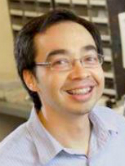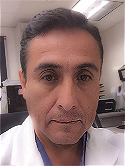Progress in reflectance confocal microscopy for imaging oral tissues in vivo Conference Paper
| Authors: | Peterson, G.; Zanoni, D. K.; Migliacci, J.; Cordova, M.; Rajadhyaksha, M.; Patel, S. |
| Title: | Progress in reflectance confocal microscopy for imaging oral tissues in vivo |
| Conference Title: | Photonic Therapeutics and Diagnostics XII |
| Abstract: | We report progress in development and feasibility testing of reflectance confocal microscopy (RCM) for imaging in the oral cavity of humans. We adapted a small rigid relay telescope (120mm long x 14mm diameter) and a small water immersion objective lens (12mm diameter, NA 0.7) to a commercial handheld RCM scanner (Vivascope 3000, Caliber ID, Rochester NY). This scanner is designed for imaging skin but we adapted the front end (the objective lens and the stepper motor that axially translates) for intra-oral use. This adaption required a new approach to address the loss of the automated stepper motor for acquisition of images in depth. A helical spring-like cap (with a coverslip to contact tissue) was designed for approximately 150 um of travel. Additionally other methods for focusing optics were designed and evaluated. The relay telescope optics is being tested in a clinical setting. With the capture of video and "video-mosaicing", extended areas can be imaged. The feasibility of imaging oral tissues was initially investigated in volunteers. RCM imaging in buccal mucosa in vivo shows nuclear and cellular detail in the epithelium and epithelial junction, and connective tissue and blood flow in the underlying lamina propria. Similar detail, including filiform and fungiform papillae, can be seen on the tongue in vivo. Clinical testing during head and neck surgery is now in progress and patients are being imaged for both normal tissue and cancerous margins in lip and tongue mucosa. © 2016 SPIE. |
| Keywords: | scanning; head and neck surgery; reflectance confocal microscopy; confocal microscopy; histology; diagnosis; collagen; reflectance confocal microscopies; reflection; tissue; musculoskeletal system; oral mucosa; clinical settings; connective tissues; optical instrument lenses; intra oral; stepping motors; telescopes; clinical testing; feasibility testing |
| Journal Title | Proceedings of SPIE |
| Volume: | 9689 |
| Conference Dates: | 2016 13–14 Feb |
| Conference Location: | San Francisco, CA |
| ISBN: | 0277-786X |
| Publisher: | SPIE |
| Date Published: | 2016-02-13 |
| Start Page: | 96891X |
| Language: | English |
| DOI: | 10.1117/12.2213692 |
| PROVIDER: | scopus |
| DOI/URL: | |
| Notes: | Conference Paper -- Conference code: 121711 -- Export Date: 1 July 2016 -- The Society of Photo-Optical Instrumentation Engineers (SPIE) -- 13 February 2016 through 14 February 2016 -- Source: Scopus |
Altmetric
Citation Impact
BMJ Impact Analytics
MSK Authors
-
 417
417Patel -
 225
225Rajadhyaksha -
 104
104Migliacci -
 30
30Peterson -
 89
89Cordova
Related MSK Work



